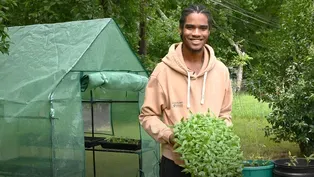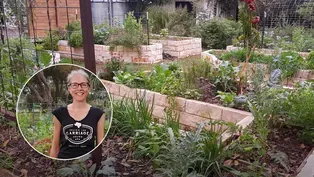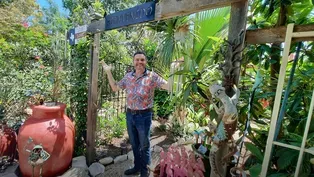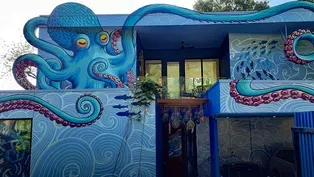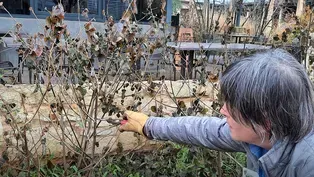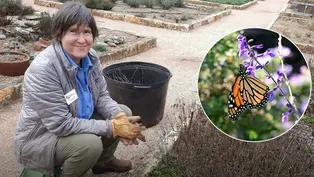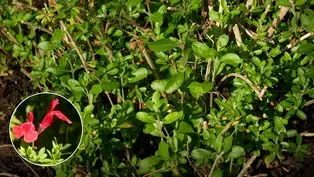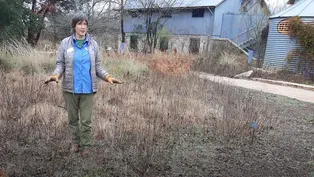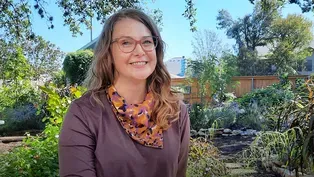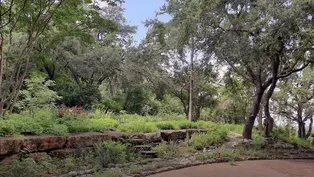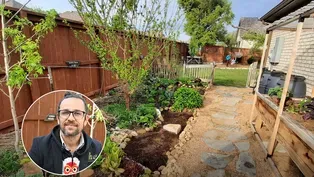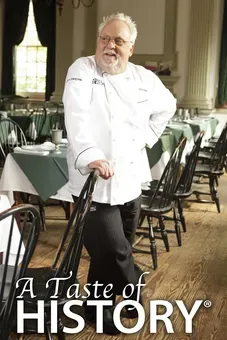
Drought Design: Change of Plans & Plants
Clip: Season 28 | 8m 55sVideo has Closed Captions
Mistakes led new gardeners back to the drawing board with native plants.
New parents Mansi Parikh and Aditya Prasad (and pup Tina) had big plans for their first garden in 2021 until harsh weather and novice mistakes sent them back to the drawing board. They rallied in fall 2022, adding more Texas-tough native perennials and annual wildflowers. By spring 2023, their toddler frolicked in flowers, along with butterflies and bees.
Problems with Closed Captions? Closed Captioning Feedback
Problems with Closed Captions? Closed Captioning Feedback
Central Texas Gardener is a local public television program presented by Austin PBS
Support for CTG is provided by: Lisa & Desi Rhoden, and Diane Land & Steve Adler. Central Texas Gardener is produced by Austin PBS, KLRU-TV and distributed by NETA.

Drought Design: Change of Plans & Plants
Clip: Season 28 | 8m 55sVideo has Closed Captions
New parents Mansi Parikh and Aditya Prasad (and pup Tina) had big plans for their first garden in 2021 until harsh weather and novice mistakes sent them back to the drawing board. They rallied in fall 2022, adding more Texas-tough native perennials and annual wildflowers. By spring 2023, their toddler frolicked in flowers, along with butterflies and bees.
Problems with Closed Captions? Closed Captioning Feedback
How to Watch Central Texas Gardener
Central Texas Gardener is available to stream on pbs.org and the free PBS App, available on iPhone, Apple TV, Android TV, Android smartphones, Amazon Fire TV, Amazon Fire Tablet, Roku, Samsung Smart TV, and Vizio.
Providing Support for PBS.org
Learn Moreabout PBS online sponsorship- I think as I become more in touch with this garden, I rediscover that there's something primal about that.
It's like a reconnection to our roots as humans.
I know it sounds kind of weird to say, but it really does feel like something that's missing from modern life, which I'm really welcoming back.
- I'm Mansi Parikh.
- I'm Aditya Prasad.
- We came to Austin about four years ago, and our dream was to buy a house with a big yard so our dog can roam free.
She's a Manhattan dog, so she's never seen space or yard.
- We bought the house in 2020.
In fact, we closed on it in March of 2020, the same week as lockdown started and the very same week we discovered that she's pregnant.
- [Mansi] So this house was meant for our toddler.
- Her brother, Urvish, and she had decided, "Okay, maybe a food forest is the right way to go."
It's funny, for the first, I don't even know how long, I was not on board at all.
When she says we were looking for a house with a big yard, I was looking for a house with no yard because I thought, "I'm gonna be the one mowing the lawn, taking care of it."
I had never done anything with plants before this.
It was about a year, actually, before we finally engaged a company to execute on it.
- [Mansi] And little did he know that garden would save his life.
- Yeah, I mean.
- In fact, the garden saved his soul from the chaos of having a baby and just all the community- - She's so right about this.
- Closing in and coming together.
The garden was his solace.
- And so they planted something like 300 perennials and fruit trees.
Little did we know, even though there's mulch in between all of them, to suppress the weeds, after a year or two, Bermuda grass, other weeds start coming up.
We didn't touch it at all, which also means, for example, we didn't adjust the watering schedule.
So if you can imagine watering these plants as much through the dead of winter as they were being watered through the height of summer, that's pretty silly.
January or February I realized, "Oh no, all the plants are dying."
And I thought, "Well, they're perennials.
They'll come back from the roots in the spring."
But come March, April, May, a lot of them didn't come back.
The roots had rotten on a lot of them because you're not supposed to water them through the winter and there are different water needs by different plants, which I hadn't thought of.
And then also we have different soil types across the land.
It's much more rocky over here.
There's much more clay over there and a mix of other things all in between.
- The whole project basically folded.
- It went off the rails so hard.
- And then he took it on as his own.
- I realized, "Okay, I need to save this thing."
And so over the last year, we've been replacing things with better choices.
So in the course of two weeks, I don't know how many dozens of hours I spent just killing the Bermuda grass, preparing the ground and getting rid of the mulch, and then buying seeds, wildflower seeds.
Laid them all out there.
I mean, just untold, tens of thousands of seeds, and just crossed my fingers.
And this spring, stuff started coming up.
What you realize after a little while doing this is what I'm really looking for is native plants.
And this is again, obvious to anyone who's been gardening for any amount of time.
But the reason that you want to pick native plants is that they're adapted to this environment.
And those plants can more or less take care of themselves and they're gorgeous.
So just knowing what to put where, it's a long learning process, super worth it.
Wherever I go now, I'm aware of what plants are around me.
Before, it was just a blur of green.
It's like, "Oh, just a bunch of weeds.
Oh, just a bunch of stuff, whatever it is."
And now I go to a place and I say, "Oh, you know, this spiderwort, it's starting to colonize," and, you know, "There's a dayflower over here."
And just getting a sense of which plants are helpful, which plants are harmful.
We love it so much.
I mean, just to take a small example, a few weeks ago, this was nothing but bluebonnets and now it's Indian blanket.
Watching those changes over the year is incredible.
You come out to almost a whole new garden every season.
- Our toddler, he's changing with, this is his first experience of a fully bloomed garden and he's changing with it.
He's learning the names of all of the flowers that are blooming.
When we go out for walks on the street or around Austin, he can point at a flower and say, "Oh, that's winecup."
When you look at the structure of this place, it's designed so that we can, at any point in the garden, we can sit down and relax and take in the beauty of the space itself.
For example, here, we often have our breakfast here in the mornings and our toddler will run out into the sandbox and play before daycare starts.
- We had planted all these perennials that provide a habitat for pollinators, for birds, for butterflies, and we realized to complete it, we wanted to actually add the sound of flowing water.
- We're admiring this beautiful pond with the deity Nataraja, who's the incarnation of Shiva.
Literally represents Shiva dancing the universe into existence.
- In each moment, that's his job.
- Each moment.
And it reminds us of how impermanent and glorious and beautiful the moment is that we're in and being able to sit down and take in our coffee and take in this nature and enjoy the birds coming by.
It's like the perfect place to land after we wake up in the morning.
The the other thing that I love about this fountain is how it sounds from our retreat room back here.
- Yeah.
- We have had so many retreats in there, hosted so many meditators, where we just open the window and hear the water and feel that .
.
.
- Energy, it feels like life.
- Energy, right.
- And it provides this beautiful sound and also it provides water for creatures that come and visit.
- Butterflies and hummingbirds, it's just magical.
I mean, they love the bee balm.
They like the Turks cap and just that whole spread over here.
So when I wake up in the morning, I can see them from my window and my son sees them when he wakes up.
He's like, "Oh, I see a hummingbird," or, "I see butterflies."
And that's how he starts his day.
It's really nice.
Since my toddler is so connected to this garden, we wanted to create a more immersive experience for him.
And so Aditya here planted a bunch of wildflowers just outside of his playroom.
While he's playing with his Legos and his toys, he can look out the window or look out the sliding doors and see fragrant flowers.
And sometimes he walks out, he wants to draw in the chalk, and he's drawing flowers that he sees in front of him.
It's really special.
- You know, our ancestors really, I mean, when we compare how we respond to a green area with how they did, I think it's a world apart.
They would be able to identify every single plant back here, and it mattered to them, because some would kill them, some would help them with, you know, some are herbal remedies, some are topical, some are foods.
They had to know this stuff.
Everyone knows about climate change and okay, there's different names for it.
There's the biodiversity loss, the biosphere collapse.
Everyone knows that something is happening on our planet and it's pretty serious.
And usually we jump directly to very narrow solutions and ideas about it.
"Oh, it's too much carbon.
We're addicted to fossil fuels."
And all those things are true, and yet, I think if you start digging into why, why is all of this happening?
For myself, anyway, what I always come back to when I peel away all the layers, is we've lost the sense of the majesty of our planet.
It nurtures us.
It's our home.
It's what gives us food.
It's what gives us life.
And we don't take very much time, or most of us, I think, don't take very much time to really appreciate her.
And it almost feels like, and I know this sounds a bit hippie, but if we have forgotten her, our mother, if we've chosen to ignore her, of course she's going to go away.
And I want to invite her back in, into our lives, into our hearts.
Growing Community: Body and Soul
Video has Closed Captions
Lenny West found his anchor and mission in providing fresh vegetables to food desert neighbors. (6m 18s)
Native Plant Garden in HOA: Martin Byhower
Video has Closed Captions
A California-to-Texas environmentalist helps neighbors garden for wildlife in extreme weather. (8m 42s)
Permaculture Design: Raised Beds and Food Forest
Video has Closed Captions
Limestone raised beds and a mandala-designed food forest honor resourceful permaculture tenets. (9m 15s)
Creating Moods in a Regular Backyard
Video has Closed Captions
Imagination, creative reuse, and spirited fun turned a backyard into a sensory voyage. (7m 41s)
Video has Closed Captions
New gardener Nancy Hall relied on plants–adapted and native–to teach her their ways. (7m 49s)
Artistic Collaboration Goes with the Flow
Video has Closed Captions
When rainwater runoff plagued a family’s home, they plunged into a whimsical makeover. (8m 25s)
Winter Pruning: Wax Mallow for Spring’s Spiderworts
Video has Closed Captions
See how to cut back wax mallow (turk’s cap) to show off spring-blooming spiderworts. (3m 25s)
Winter Pruning: Mealy Blue Sage
Video has Closed Captions
See where to cut back old stalks on perennial mealy blue sage. (3m 16s)
Video has Closed Captions
Learn how to prune this evergreen woody shrub/subshrub. (4m 47s)
Video has Closed Captions
See why to progressively prune grasses and herbaceous perennials. (1m 35s)
Garden Makeover Grows New Friends and Career
Video has Closed Captions
Jennie Ostertag broke a few shovels changing her yard and life’s path. (9m 18s)
Video has Closed Captions
James Truchard created diverse habitats to offset a future of climate changes. (8m 49s)
Drought Design: Change of Plans & Plants
Video has Closed Captions
Mistakes led new gardeners back to the drawing board with native plants. (8m 55s)
Side Yard Garden Permaculture Design
Video has Closed Captions
A narrow side yard supports food and flowers with permaculture techniques. (8m 1s)
Front Yard Native Plant Wildlife Habitat
Video has Closed Captions
Removing lawn for native plants brings pollinators to a young couple’s front yard. (9m 35s)
Providing Support for PBS.org
Learn Moreabout PBS online sponsorshipSupport for PBS provided by:
Central Texas Gardener is a local public television program presented by Austin PBS
Support for CTG is provided by: Lisa & Desi Rhoden, and Diane Land & Steve Adler. Central Texas Gardener is produced by Austin PBS, KLRU-TV and distributed by NETA.
